Heliar
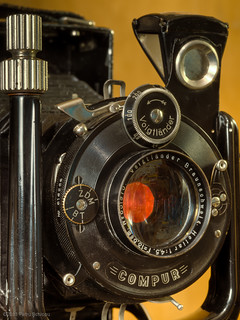
|
| Voigtländer Braunschweig Heliar 1:4.5 f=13.5cm on Voigtländer Bergheil image by Petru Schiopu (Image rights) |
The Heliar is a lens designed and made by Voigtländer. It was developed in 1900 by Dr. Hans Harting, and patented in Germany (1901), Britain (1901) and the USA (1902)[1], originally as a symmetrical 5-element variant of the simple anastigmatic and well color-corrected Cooke triplet. It comprises five glass elements: the plano-concave front group and the equal back group are both cemented doublets of positive power, composed of a crown glass element at the front, cemented to a flint glass; there is a central biconcave diverging element of a different crown glass.[2]
In 1902 a revised asymmetrical version was patented which became the lens type known as the Heliar. The patent describes it as improvements of the previous design, for a lens not rendering the image perfectly true, but therefore correcting astigmatism, curvature and coma better than the original design. The back group became biconvex, the front group became convex-concave, and the groups' distances to the middle biconcave single-element group became asymmetrical.
Kodak patented one of its Ektar lenses with a similar but not identical concept. Dallmeyer's Pentac was almost like the Heliar, but a little faster. Voigtländer itself created variations of the Heliar. The position of the two cemented converging lens elements could be inner or outer elements of the lens. The latter concept was taken over in 1925 from the Dynar lens to achieve a Heliar design for faster speed f3.5.

|
| Voigtländer Braunschweig Heliar 1:4.5/24cm image by phollectormo (Image rights) |
The original Heliar design was an f/4.5 lens; f/3.5 versions of the same optical design were offered since 1925 (alongside the f/4.5), a design again with front and back group both being plano-convex but of different size and with the biconvex elements as outer lens elements, thus resembling as well the Dynar as the Tessar. The wider-aperture lens has a slightly narrower field of view.[3]).
Voigtländer used the lens in the way Zeiss used the Tessar; it was the lens fitted to most of the company's high-specification cameras for many years. Large format versions like the Universal-Heliar 1:4,5 F=30cm were available, the latter a real special lens with the original 1902 design but with middle element adjustable by user for image softening effects.
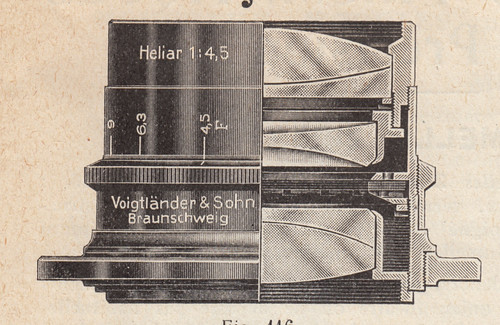
|
| Voigtländer&Sohn Heliar 1:4.5, alternate concept that allowed f3.5 variants scanned by Dirk HR Spennemann (Image rights) |
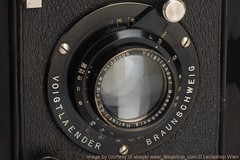
|
| Voigtländer Braunschweig Heliar 1:4.5 F=12cm image by ebayer www_leicashop_com (Image rights) |

|
| f3.5 Color-Heliar for Voigtländer Bessa medium format folders image by Paulo Moreira (Image rights) |
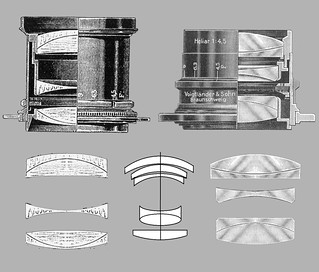
|
| Cosina's new Color Heliar (middle) vs. Voigtländer's old Heliar concepts left: 1902 variant, right 1925 variant, from which the original Color-Heliar was derived image by Uwe Kulick (Image rights) |
Modern Heliar and APO-Lanthar
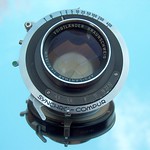
|
| Apo-Lanthar 1:4.5 f=150mm large format lens image by Gerard Vogels (Image rights) |
In 1950 the team of Dr. A.W. Tronnier refined the Heliar design to the Color-Heliar for medium format cameras, based on the alternate design, whilst at the same time the large format Heliars had the original 1902 design. A true redesign by Tronnier with the new Lanthan glass had better lens fault corrections, but was explicitely not marketed as Heliar but as APO-Lanthar since the Heliar's remaining lens faults were seen as the lens' characteristics! Another good reason was that the new lens was the world's first apochromatic lens, meaning color-corrected for 3 instead of 2 spectral colors.
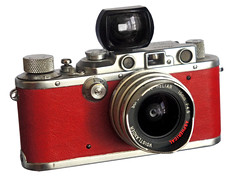
|
| Super Wide Heliar on Leica III image by Romuald Swieconek (Image rights) |
Later Voigtländer or its successor Cosina managed to develop new Heliar lenses for 35mm format which are much faster or have a much wider angle of view, in a wide range from ultra wide angle 12mm to telephoto 180mm. Therefore new lens designs with 6, 8 or 10 elements were derived from a completely new design of the Color-Heliar 75mm. The old Heliar concept was only revived for the standard lens focal length 50mm, but very successfully concerning the resulting quality.
The new basic concept was Cosina's Voigtländer Color Heliar 75/2.5, resembling a bastard of Voigtländer's Ultron and Zeiss's medium format Planar 2.8/100. Obviously Cosina wanted to create a kind of 'German' quality lens. Cosina's APO-Lanthar 90/3.5 got basically the same 6-element construction. Similar constructional characteristics of the new wide-angle Heliars are 3 uncemented single-element groups close together in the front and one cemented two-element group as second group when counted from the back.
| focal length | aperture | elements | groups | iris blades | angle of view | |
|---|---|---|---|---|---|---|
| Ultra Wide Heliar | 12mm | f5.6 to f22 | 10 | 8 | 9 | 121° |
| Super Wide Heliar | 15mm | f4.5 to f22 | 8 | 6 | 10 | 110° |
| Heliar | 50mm | f3.5 to f22 | 5 | 3 | 10 | 46° |
| Heliar | 50mm | f2.0 to f22 | 5 | 3 | 11 | 46° |
| Heliar | 75mm | f1.8 to f16 | 6 | 3 | 10 | 33° |
| Color-Heliar | 75mm | f2.5 to f16 | 6 | 5 | 10 | 32° |
| Color-Heliar | 75mm | f2.5 to f22 | 6 | 5 | 9 | 32° |
| APO-Lanthar | 90mm | f3.5 to f22 | 6 | 5 | 10 | 27° |
| APO-Lanthar | 90mm | f3.5 to f22 | 7 | 5 | 9 | 27° |
| Color-Heliar | 125mm | f2.5 to f22 | 11 | 9 | 9 | 32° |
| APO-Lanthar | 180mm | f4.0 to f22 | 9 | 7 | 9 | 14° |

|
| Bessa-T w/ Apo-Lanthar 90mm F3.5 image by Carlos Santisteban (Image rights) |
Notes
- ↑ Greenleaf, Allen R. (1950), Photographic Optics. Macmillan, New York. pp80 & 83.
- ↑ US Patent 716035 of 1902, in the name of Carl Harting, for Voigtländer, at Google.
- ↑ A Voigtländer catalogue of 1927, at Camera Eccentric shows both the f/4.5 and f/3.5 lenses. The angle of view of the f/3.5 lens is given as about 50°; that of the f/4.5 is given as about 58° (up to focal length of 24 cm; for some reason (perhaps simply bellows extension) it is given as 45° beyond that.
Links
- Japanese wikipedia article, listing all focal lengths
- partial translation of this page's main source], text by F. Mechelhoff, on appcott.co.uk (archived)
- A short history of the Heliar lenses with list of serial numbers at Antique & Classic Cameras